
|   |

|   |
 e-mail: sunilkothari1933@gmail.com Nitya Nritya Dance Festival 2016 October 21, 2016 Dr. Lalitha Srinivasan has been holding annually under the aegis of Nupura, her dance institution in Bangalore, Nitya Nritya dance festival for the past 30 years. There was a break for few years, but for past 7 years she has resumed the annual dance festival with seminars. I have attended in early 80s and participated in seminars. With Aloka Kanungo I had given an illustrated talk with slides of Odisha temple sculptures to which Aloka had performed various poses as created by Guru Kelucharan Mohapatra. In earlier years I was fortunate to witness abhinaya by legendary Venkatalakshamma from Mysore. Ah, what a treat it was! As a matter of fact it all started with Lalitha's wish to visit temples in Odisha, Tanjore, see Rasalila in Imphal, Manipur. Late BVK Sastry, a friend of Lalitha and Srinivasan suggested why not organize a conference in Bangalore and invite great gurus and dancers, hold seminars and performances, so that dance lovers of Bangalore also can witness their great art. From these concepts, Nitya Nritya festival started and all the major gurus and dancers of different dance forms participated and performed. Name them and they have all visited Bangalore. Gurus Kelucharan Mohapatra ( Odissi), Vempati Chinna Satyam (Kuchipudi), Bipin Singh (Manipuri), Durgalal (Kathak), Yamini Krishnamurthy (Bharatanatyam), Jhaveri Sisters (Manipuri), Dr. Padma Subrahmanyam (Bharata Nrityam), Chandralekha (Innovative) with her contemporary work, Kalanidhi Narayanan (Abhinaya) and so on. In recent years, Ramli Ibrahim from Malaysia (Odissi), Anita Sarma and troupe (Sattriya) from Assam have performed. Malavika Sarukkai (Bharatanatyam) has performed in Nitya Nritya festival during celebration of World Dance Day. For the past three years the festival dates were changed, so I was unable to attend for the last two years. The inauguration of the seminar on 30th September in the morning at Bharatiya Vidya Bhavan was done by young and dynamic musician and neuroscientist Dr. Deepti Navaratna, recently appointed Executive Director of Indira Gandhi National Centre for Arts, Southern Region Centre (SRC), Bangalore. After 8 years working at Harvard in USA, Dr. Deepti Navaratna decided to return to Bangalore and has chosen to work at IGNCA, giving up her career as a neuroscientist, concentrating more on classical Carnatic music and activise the IGNCA centre with lots of activities. The Centre was earlier headed by musician, musicologist, author, scholar, writer Dr. Vikram Sampath who has moved to Symbiosis International Institute. Deepti has several projects up her sleeve and it was a pleasure to learn about it from her. The approach and focus are on grassroots work and getting school children involved to inculcate in them an awareness of Indian cultural heritage. With resources at the disposal of IGNCA this would augur well for the centre. Dr. Choodamani Nandagopal, the renowned art historian and UNESCO Fellow gave a key note address on 'Relevance of Performing Arts in Education' drawing attention to its value, the sad state that prevails in Universities, but emphasising the importance of the relevance of performing arts instead of limiting to only performing classical dances, making the courses inclusive with allied arts and thereby elevating the standard. We all who are involved in teaching performing arts, practical and theoretical, know that it has been an uphill task. The job opportunities are few and even with Ph D in Dance there are few openings to teach. However, with awareness that jobs can be created in field of culture and also at various schools with dance as a compulsory subject for few years at the initial stage, jobs could be created. Dr. Choodamani suggested that we have to empower teachers who in turn will empower students and gave information that at Jain University where she was Professor, now some 20 students have registered for art courses at a higher level. That is good news. Hers was an illuminating lecture keeping with her erudition. As per the format evolved over the years, Lalitha Srinivasan always presents few up and coming male and female dancers. Anil Iyer, a disciple of Guru Poornima Gururaj, gave a solo Bharatanatyam performance. He chose to perform Surya stuti and Swati Tirunal's composition weaving in sancharis of how Sarasijnabha lord protects his devotees like episode of Gajendra Moksha. The composition was interesting for having two aspects. Krishna stealing clothes of Gopis when they were bathing, and then when Drauapdi begged him to protect, he saved her by providing endless saris and saved her from Dushashan. He vanquished Kaliya serpent and he sleeps on Sheshanaga, he shows to Yashoda the entire universe when she chides him for eating earth, and also shows Vishwarupa to Arjuna. Anil Iyer is a competent male dancer but needs to polish his movements further. He has pleasant stage presence and ability to project abhinaya. It is in pure dance and execution of lines that more polish would help create pleasant impression. Evening performances were held at Chowdiah Hall. Inauguration was by eminent musician and scholar Dr. T.S Satyavathi. Nupura disciples presented four nayikas out of eight – Ashtanayikas in group choreography by Lalitha Srinvasan. It was followed by Dr. Gowri Ramnarayan's 'Dance in her Song,' a tribute to M.S Subbulakshmi, conceived, scripted and directed by her with Sheejith Krishna on nattuvangam and two Kalakshetra trained dancers Anjana Anand and B. Rajamally, performing to the songs of MS rendered by Savitha Narasimhan, evoking nostalgia. Ashtanayika was conceived to highlight the state of mind a nayika is in vis-a-vis the nayaka. The solo treatment and then other three dancers taking tableau positions were visually interesting. The stage was too large for the small group of four dancers - Anusha, Pujita Padmanabhan, Sri Vidya Somaiya and Sahana Das. Earlier, Ajay Viswanathan and Anusha performed in a seamless manner a duet, to various slokas which was sparkling, effortless and in druta tempo quite spirited. Ajay impressed with his vigorous tandava. The depiction of Proshitabhartrika, Kalahantarita, Abhisarika and Swadhinbhartrika was executed well and nritta to the use of swaras and sollus lent texture. They acquitted themselves well and performed with clean neat lines and movements. 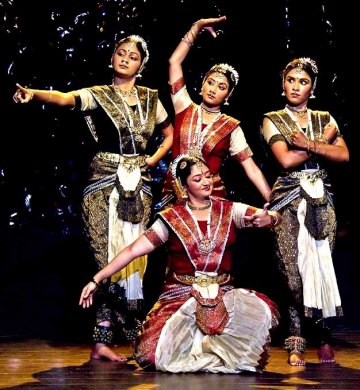 Nupura dancers 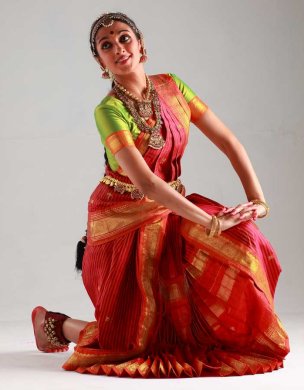 Anjana Anand Dr. Gowri Ramanrayan has created a niche for herself with her JustUs Repertory unit. She had the good fortune to accompany MS during her performances and inherits a treasure trove of great music. The focus was on Bharatanatyam dance to which MS sang when Gowri's mother Anandi and Radha performed Bharatanatyam. It was interesting to learn that Ramaiah Pillai had trained them in Bharatanatyam and also choreographed few dance items. Also MS herself had performed Bharatanatyam and some rare photos were published in Kalki magazine. The repertoire of MS's songs is well known and majority of South Indian audiences everywhere are familiar with those songs. The program was remarkable from the point of view of how in early years, classical Bharatanatyam was a part of MS. This being centenary year of MS there has been a plethora of programs. But this presentation was interesting and offered glimpses into dance in songs of MS. On account of several programs in the city the audience presence was thin. Also the traffic poses several problems in Bangalore. On 1st October at Bharatiya VIdya Bhavan, Preeti Sundarraj with help of demonstration, audience participation dwelt upon different ways of teaching dance to school children. The process and how creative movement can be introduced. With clippings of video the method was illustrated. Tripura Kashyap's seminal work on Therapeutic Dance in Education is well known. Her talk with several insights into how dance can provide therapeutic help was illuminating. Her own studies abroad in this aspect have helped her evolve a methodology for students and have earned her good dividends in her career. The video clippings helped in explanation of her methodology. Prashanth Shastry, disciple of his late mother Prabhavati Shastry, and studying under Lalitha Srinivasan is a well known dancer with his background in TV serials and Kannada and Tamil films. He has a pleasant personality. After Lord Siva's dance in the evening, Pradosha Tandava in Purvi Kalyani and adi tala performing vigorously, Prashanth presented Ashtaragamalika Varnam in praise of Lord Brihadishwara. The depiction of Tanjapuri, the temple, the beauty of the divine Lord, with matted locks, Ganga residing there, half crescent moon decorating the jata, wearing elephant hide, taking Kalakuta poison and beseeching lord's love, Prashanth succeeded in displaying his command over nritta. In expressions there needs to be a quiet approach. The musicians gave him able support. Sri Vatsa's melodious full throated singing and Lalitha Srinivasan's meticulous nattuvangam to the excellent mridangam accompaniment by Narayanaswamy were most impressive. It is a wonderful varnam and the treatment with such high power nattuvangam and music showed that with all his command over tala and laya, Prashanth found it difficult to match it. However one admired his complete involvement. In tillana, the broad sweeping movements were arresting. With Bharatavakyam the solo concluded. Prashanth has potential to bloom into a brilliant solo performer. The evening performances were scheduled at KEA Prabhat Rangamandira. It is a well designed auditorium and one hopes with the passage of time, it will become popular with the dancers and musicians. In order to access easily, the organizers should print a map also as on main road there is no sign placed to indicate where it is located. The program began with Bharatanatyam solo and duet performances by the disciples of Guru M.R. Krishnamurthy who runs his institution Kalakshiti. A former disciple of Rukmini Devi, he faithfully adheres to Kalakshetra bani. His disciples have that distinct stamp. Amrita Lahari presented prayer in praise of Lalitambike, with poetic epithet for the goddess describing her in all its glory. Shri Chakraraj Simhasaneswari, Agamavedakalamayarupini, Akhilacharacharjanani, Rajarajeswari and so on. Amrita took various iconic postures which looked visually attractive. The mood was complete bhakti bhava. Another composition of Swati Tirunal was choreographed by Janardhan in praise of Anjaneya, Ramadoot, who in childhood had attempted to catch the globe of Surya. Hanuman is described by the poet as more powerful than hundreds of elephants. As Ramadoot, he met Sita and gave her Rama's ring, set Lanka on fire. These episodes were enacted by Suchitra and Chetna as a duet. Gagana enacted ashtapadi 'Pashyati dishi dishi' with intense emotion, as Sakhi tells Krishna about Radha's state, her waiting for Krishna and requests him to go and meet her. This was also choreographed by Janardhanan and was in nature much restrained and dignified. The next duet was a popular Saint Raidasa's bhajan in which Raidasa tells the Lord that he is like chandan (sandal) and the devotee like water. Various upamas, similes like cloud and peacock, lamp and wick, pearl and thread, and finally lord is the swami and devotee his servant. The presentation concluded with tillana composed by Sitarama Sharma by three dancers who covered the stage with periya adavu bringing out the scintillating quality of tillana. The entire program was neat, replete with bhakti and displayed the customary high standard of Kalakshetra. From Kolkata, Guru Bipin Singh's daughter Bimbavati brought a whiff of fresh air with her innovative choreographic works in Manipuri. She has inherited the art from her parents but has also gone a step ahead in incorporating movements of Thang Ta martial arts in her choreographic works. The traditional numbers like Madhur Nartan, choreographed by Bimbavati had the will o the wisp quality of graceful Manipuri dance. Petal soft footwork and simitanga, restrained angikabhinaya were the highlights of her solo. What Bimbavati has earned praise for is extending the boundaries of thematic content of Manipuri dance, which has predominant theme of Radha and Krishna and Rasalila. Manipuri dance is known with its circular mirrored skirts and colourful costumes of Rasalila. Bimbavati has chosen to choreograph Sanskrit prayers in praise of Lord Shiva. She used makara mantra from Om Namah Shivaya successfully. Shiva holding trident and with third eye were depicted with Thang Ta movements. Her other contribution is to choreograph items on Devi, Goddesses like Shakti, Durga, Annapurna, Kali. She has incorporated movements from Lai Haraoba and few steps from folk dances including the tunes. When enacting goddesses vanquishing Bimbavati uses sound, cries, cutting heads of demons. And her delicate frame acquires the energy of the goddesses. While depicting Annapurna, Bimbavati uses props, a basket full of grains, poured ritualistically in a plate. The visuals look attractive. Her troupe consisted of one Manipuri dancer, her niece and two Bengali dancers with one male Bengali dancer. They have received uniform training in Guru Bipin Singh's style. One choreographic number based on greed and desire titled Nirvak,was familiar episode of Ramayana where Maya mriga golden deer entices Sita which results in her being kidnapped by Ravana. Dancing as deer and also as Ravana as a mendicant Bimbavati created illusion, the dancer playing role of Sita, crying for help, throwing ornaments from sky et al were performed with consummate artistry in Manipuri idiom. Bimbavati did present Radha Krishna Yugal nartan in Rasalila costumes with mirrored skirt and gossamer veil for Radha and Krishna with his peacock crown and yellow silk pitambar. The Manpuri aharya is extremely colourful and unusual. Both dancers performed the duet in which Radha performed in lasya and Krishna in tandava style. Extending boundaries of Manipuri dances is a welcome attempt as her generation is bound to explore the medium with innovative ideas. On the final day on 2nd October in the morning session I missed Ajay Viswanathan's presentation of 'Dance and Self,' his personal journey. Working in a firm of information technology, how the self has to improve one's personality and be aware of pitfalls were explained by him, I am told. He is a versatile dancer and continues to perform along with his demanding job. Chitra Arvind spoke about her experiences with hearing impaired students in a school, where she is taking workshops twice a week. She has evolved a method of teaching students dance movements making them count say eight and then follow what she does in terms of movement. She said that though they cannot hear, their memory power is amazing. She has not learnt sign language but finds that somehow the students understand her methodology. She has succeeded in making shy students become bold and enjoy dancing. She has worked out the system of giving cue. She invited dancer Prashanth and another student who were told to follow the cue along with the hearing impaired students. She showed with fingers counting up to eight and then gave signal to two students who cannot hear to follow the movement and also improvise. It was heartening to see the two students performing and moving with confidence. Chitra is a trained Bharatanatyam and Kathak dancer, has studied modern dance with Shobana Jeysingh's company in London and has returned to Bangalore choreographing both classical dances and also contemporary. She has added this activity to serve the less privileged students. Her experience is rewarding, says Chitra, as students feel confident and seem more receptive. 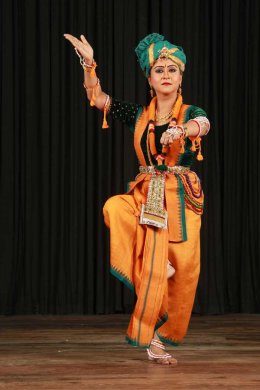 Bimbavati Devi
Bimbavati was to conduct a lec dem on Manipuri, but she had to return to Kolkata, so her troupe members gave a very interesting demonstration of various body movements, chalis, groupings of movements termed by Guru Bipin Singh as Lasantika chari, in which feet do not go up to knee level, Sampluta chari in which dancers take leaps above ground level. The dancers gave information of male dancers performing pung, khol, mridang, playing with cymbals, clappings known as khubak ishai, Natapala, two drummers and the third drummer in a group performing various talas. They also explained Bimbavati's experiments in using themes of Shakti and Shiva. They danced an item of Maibi dance, of the priestess from tantric dance form like Lai Haraoba and mentioned about pre-Vaishnavite gods and goddesses. Finally they danced to Tagore's Bengali song 'Akashabhara' choreographed by Bimbavati. The audience response was encouraging. Chitra Arvind wanted to learn even the way Manipuri dancers perform salutation. It was suggested that Bharatiya Vidya Bhavan should arrange for a ten day camp and dancers from different dance disciplines should participate and learn basic movements of Manipuri and then after a week also perform a dance item. The enthusiasm on part of dancers appeared encouraging for a lesser practised form like Manipur in Bangalore. Before concluding the morning session there was a Bharatanatyam recital form students of Mysore University and Dr. Rohila Eswar, disciple of Guru Nandni Eswar. Rohila Eswar is a lecturer in archaeology department. He and four female dancers performed to the songs rendered by MS Subbulakshmi as homage to MS. A few songs were performed to the records of MS. The morning session ended almost at 1.30 pm. In future for morning sessions it would be good to limit the time limit else audience gets thinner. In the evening at KEA Prabhat Rangamandira, Dr K. Radhakrishnan, former chairman of ISRO, was the chief guest. He is also a renowned classical musician. He recommended to include Kutiyattam performances in the festival. The highlights were Odissi exponent Sharmila Mukerjee and her troupe's choreographic works and solo items and Bharatanatyam Ensemble by Guru Bhanumati's troupe. Both the presentations were of a very high standard. Sharmila and her troupe performed Mangalacharan and Trikhandi Pranam, based on Guru Kelucharan Mohapatra's choreography, re-adapted by Sharmila for group set to Shivaranjani raga in ekatali tala. Goddess Lakshmi's various iconic figures like multi–armed form, Gajalakshmi form, Nanalankaravibhushita, decorated by various ornaments and Jagannmata, mother of Universe form were performed in a seamless manner. Pallavi set to Charukesi and ekatali tala in a solo by Sharmila was joined by the group towards end, using sculpturesque combinations of alasa, chain formation, motif of women holding lamp, and ending in druta, fast tempo. Ashtapadi "Sakhi he keshi madanamudaram" dwelt on Radha's first encounter with Krishna, reminisced by Radha in a solo by Sharmila to the choreography of Kelubabu was an evergreen item revealing Kelubabu's genius. Radha as abhisarika nayika and encounter with Lord Krishna with emphasis on shringara remains one of the finest choreographies of Guruji. Muslim poet Salbeg's prayer to Lord Jagannath has interesting sancharis of Gajaraj moksha, protecting Drauapdi, Hiranyakashipu and Prahlad and how the lord protects the devotees. Set to Arabhi raga it is known as Janano. Also it shows that though Muslim, the devotee of Lord Jagannath can get god's grace and glimpse. Moksha the final number in Odissi includes sholkas praising Goddess and ends one quiet note –with Shanta rasa. Sharmila and her troupe received excellent ovation. 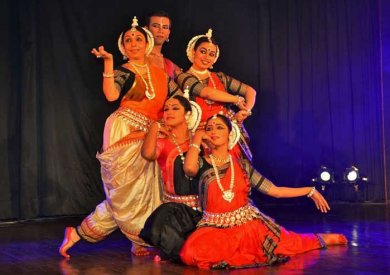 Sharmila Mukerjee and group 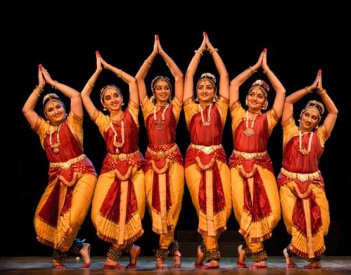 Bhanumati's group Guru Bhanumati has rightfully won appreciation for her imaginative choreography. After traditional Mallari, using anjali hasta the first group choreography revealed several architectural forms. Followed by her mother's composition on Lord Muruga in Ragamalika detailing various sanchari bhavas of key incidents of Kartikeya's deeds, story of Brahma kept as captive for not knowing Om pranava mantra. Lord Shiva learning it from Shanmukha and releasing Lord Brahma, dancing Kavadi, Muruga riding over peacock et al in quick succession kept audience in a thrall. But what bowled over audience was her brief five minute choreography of Tulasidas's prayer "Shri Ramachandra Kripalu bhajamana" with tableau of principal events of Ramayana like paintings. Bhanumati received rounds of applause for this choreography. Brevity as soul of art was seen in this imaginative number. The finale with Oothukadu Venkata Kavi's "Kalinga nartana" had recitation like bols of kavit of Kathak and the duel between Kaliya and Krishna along with the entire group work was brilliant. The musicians gave customary perfect support. The three day bonanza was enjoyed by faithful followers of Lalitha Srinivasan and Nupura, braving all hazards of Bangalore traffic. And reaching different venues. For next year, they would do well to limit the participation of many artists in the morning sessions. The seminars are important as it is necessary to have interaction with academicians and dancers. If the organizers can resolve to have one venue in the evening for all days, it would ensure better audience.  Dr. Sunil Kothari is a dance historian, scholar, author and critic. He is honored with Padma Shri, Sangeet Natak Akademi award and Senior Critic Award from Dance Critics Association, NYC. Post your comments Please provide your name and email id when you use the Anonymous profile in the blog to post a comment. All appropriate comments posted with name & email id in the blog will also be featured in the site. |